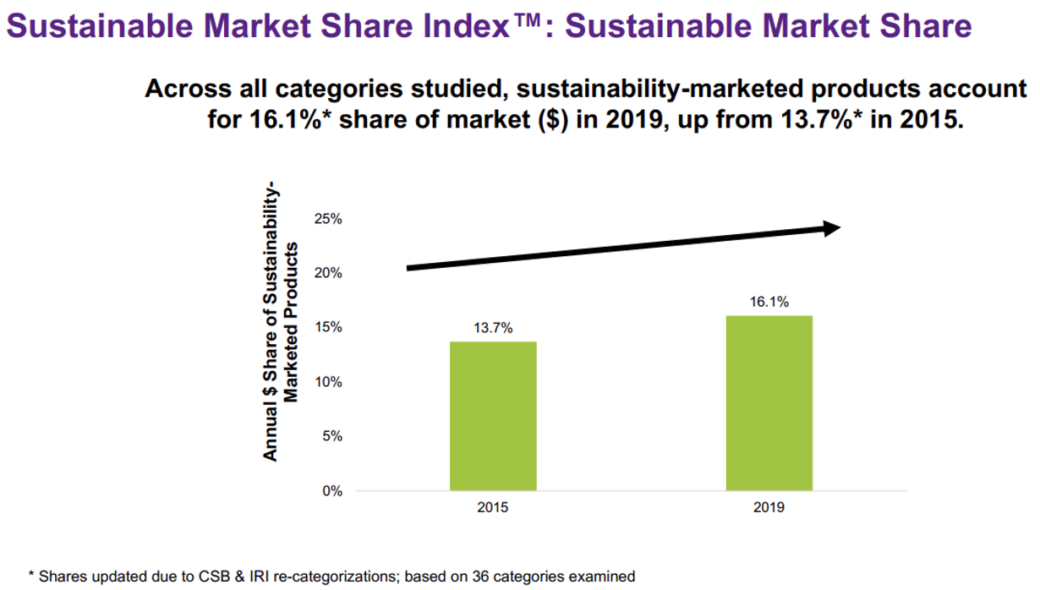
Making your e-commerce business sustainable is a noble—if not necessary—undertaking today, but many owners think that “going green” risks hurting sales and profits. Sustainable goods cost more, and it’s too much of a hassle for customers to shop for them, or so goes the common thinking.
Fortunately, these “facts” simply aren’t true. In fact, building a sustainable store is good for business. Yes, sustainable goods often do cost more, but a growing percentage of customers—particularly younger and more affluent ones—are willing to pay for them. Sustainability also builds customer loyalty and improves brand reputation and recognition, creating even more customers. That translates into higher sales and profits. Fact is, sustainability is where the growth is. Add to that a more sustainable delivery process—with less packaging, fewer returns and more efficient shipping procedures—that can mean a healthier bottom line.
Check out these figures from the March 2021 Sustainable Market Share Index published by New York University’s Stern Center for Sustainable Business:
- Products branded as sustainable enjoy a price premium of nearly 40% over comparable conventional goods.
- Yet, sales of sustainability-marketed products grew more than seven times faster—21.4% versus 3.0%—than products not marketed as sustainable, and nearly four times faster than the consumer-packaged goods (CPG) category as a whole.
- Sales of products promoted as sustainable accounted for more than 55% of CPG market growth during the 2015-2019 period despite representing only 16.1% share of the entire category.
- Sustainable products now account for nearly 17% of all purchases, up from less than 14% in 2015.
- Sustainability-marketed products have a larger market share online compared to brick-and-mortar stores.
- Upper income, millennials, college-educated and urban consumers are more likely to buy sustainability-marketed products, although middle income, Baby Boomers and Gen Xers contribute a significant share of sustainable sales.
“Consumers want to buy sustainable products and e-commerce retailers can help them do so by sharing environmental and social data on their online platforms,” said Tensie Whelan, professor and director of the NYU Stern Center for Sustainable Business. “Whether companies choose to jump at this opportunity will determine their ability to cultivate the consumer and remain competitive over the long-run.”
According to a survey by NielsenIQ, nearly half (48%) of U.S. consumers surveyed in 2018 said they would definitely or probably change their shopping habits to reduce their impact on the environment. Between 2014 and 2018, sustainable product sales grew by nearly 20%, a compound average growth rate more than four times faster than conventional products. In fact, between 2014 and 2017, sustainability’s share grew by nearly three percentage points, while conventional products’ share of sales fell by almost four points. By 2021, Nielsen expects sustainable products’ market share will have grown to 25% of total consumer sales from 22% in 2018.
Like NYU, Nielsen also found a big difference in the shopping preferences of younger versus older consumers. Millennials are twice as likely as Baby Boomers (75% to 34%) to say they are definitely or probably changing their habits to reduce their impact on the environment. Millennials are also more likely (53% to 34%) to say they’d be willing to choose a product marketed as environmentally friendly. They’re also more willing (90% vs. 61%) to pay more for products that contain environmentally friendly or sustainable ingredients.
How to become more sustainable

In the commercial context, sustainability has two meanings, although both add up to the same thing. According to the UN World Commission on Environment and Development, sustainable development means meeting “the needs of the present without compromising the ability of future generations to meet their own needs.” But as the NYU and Nielsen results show, companies that adhere to this principal help sustain their own existence and viability as thriving enterprises.
There are many ways e-commerce companies can promote sustainability in the way they do business, the products they sell, how they package them, and how they deliver them to their customers’ doors. Here’s what you can do:
Sell eco-friendly products
This one seems the most obvious. What you sell says the most about your values and dedication to sustainability. This could mean providing more eco-friendly alternatives to existing products or those that allow or encourage people to live more sustainably. And customers will find you, given some marketing assistance. Nielsen found that, by 74% to 46%, millennials find it easier than Baby Boomers to find environmentally friendly products in the stores where they shop.
Source locally

Think about it: What costs more and burns more energy—trucking something cross-country or getting it from a supplier overseas, or getting the same or a similar product from a local supplier? Dealing with local suppliers also gives you the opportunity to see first-hand how sustainable their business and production processes are.
Use green packaging
Needless to say, packaging is very important in e-commerce. If your product gets to the customer damaged, you’ve lost the sale—and maybe the customer for life. But you can pack smarter. Think more cardboard, paper and recyclable materials and less plastic.
“Properly designed packaging, used effectively, can significantly reduce waste throughout the supply chain,” says John Wetherall, former business development director at of MacFarlane Packaging, the UK’s largest packaging distributor. “When planned well, the right packaging will reduce shipment weights, product damage and returns rates, all of which contribute to achieving sustainability goals.”
Reduce shipping
It may not always be possible but consolidate shipments as best you can. You don’t want to have multiple vans going to the same address—it’s wasteful—not to mention the extra packaging involved. And the smaller the box, the better for everyone. You’ll save money either way. Where possible, offer customers the option of picking up their packages at a local store or delivery station.
Eschew returns
Speaking of returns, nothing eats into profits like product returns—and your customers don’t like it either, especially if they have to pay return shipping. It’s also not environmentally friendly, with all those trucks having to make additional trips. But there are steps you can take to minimize returns:
- Don’t offer free return shipping. If you have retail outlets, offer free returns there.
- If it’s a low-cost item, tell the customer to keep it or ask them to donate it to someone else.
- Creating better product descriptions that tell customers exactly what they are buying can also reduce returns.
Nobody said being sustainable doesn’t take some effort. But it’s definitely worth it. And after a while, steps like these will become second nature. There’s no reason why going green shouldn’t add some green to your business.
To learn more about FOCUS’ e-commerce Team, contact Leah White [email protected].















